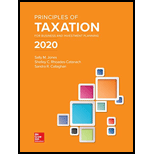
Contrast the income tax consequences of the yields on the following investments:
- a. U.S. Treasury bonds.
- b. Bonds issued by the State of Illinois.
- c. Bonds issued by a publicly held corporation at their face value.
- d. Bonds issued by a publicly held corporation at a discounted value.
- e.
Preferred stock issued by a publicly held corporation. - f. Shares issued by a mutual fund.
a.
Indicate the income tax consequence for the Country U Treasury bonds.
Explanation of Solution
The interest from Country U’s treasury bonds is considered as the taxable income for federal purposes however tax-exempt for state purposes.
b.
Indicate the income tax consequence for the bonds issued by the State I.
Explanation of Solution
The interest from the State I bonds is tax-exempt for federal purposes however it might be taxable income or tax-exempt income for state purposes and it depends on the taxpayer’s state of residence.
c.
Indicate the income tax consequence for the bonds issued by the bonds issued by a publicly held corporation at their face value.
Explanation of Solution
The specified interest paid for the corporate bonds is considered as the taxable income for federal and state purposes.
d.
Indicate the income tax consequence for the bonds issued by the bonds issued by a publicly held corporation at their discounted value.
Explanation of Solution
The specified interest paid for the corporate bonds and the amortization of the OID (Original issue discount) is considered as the taxable income for federal and state purposes.
e.
Indicate the income tax consequence for the preferred stock which is issued by the publicly held corporation.
Explanation of Solution
The dividend which is on the preferred stock is considered as the taxable income for the federal and state purposes. The qualified dividends income is taxable at the preferential federal rate.
f.
Indicate the income tax consequence for the shares that are issued by a mutual fund.
Explanation of Solution
The ordinary dividends which are paid by the mutual funds are the combination of ordinary taxable income, capital gain distributions and qualified dividend income. The qualified dividend income and capital gain distributions are taxed at a special federal rate.
Want to see more full solutions like this?
Chapter 16 Solutions
Principles Of Taxation For Business And Investment Planning 2020 Edition
 EBK CONTEMPORARY FINANCIAL MANAGEMENTFinanceISBN:9781337514835Author:MOYERPublisher:CENGAGE LEARNING - CONSIGNMENTPrinciples of Accounting Volume 1AccountingISBN:9781947172685Author:OpenStaxPublisher:OpenStax College
EBK CONTEMPORARY FINANCIAL MANAGEMENTFinanceISBN:9781337514835Author:MOYERPublisher:CENGAGE LEARNING - CONSIGNMENTPrinciples of Accounting Volume 1AccountingISBN:9781947172685Author:OpenStaxPublisher:OpenStax College Intermediate Accounting: Reporting And AnalysisAccountingISBN:9781337788281Author:James M. Wahlen, Jefferson P. Jones, Donald PagachPublisher:Cengage Learning
Intermediate Accounting: Reporting And AnalysisAccountingISBN:9781337788281Author:James M. Wahlen, Jefferson P. Jones, Donald PagachPublisher:Cengage Learning





